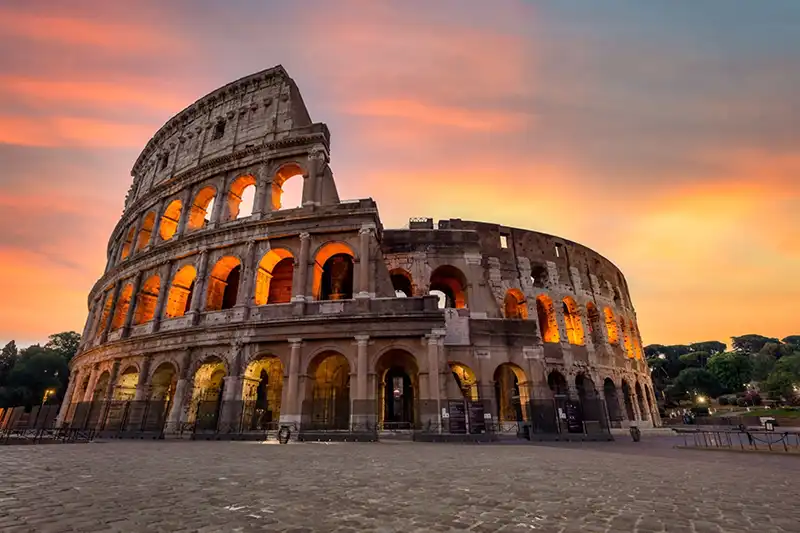Rome: A Timeless Journey Through the Eternal City
Rome, the Eternal City, is a place where millennia of history, art, and la dolce vita collide. From the echoing footsteps of gladiators in the Colosseum to the whispered prayers beneath Michelangelo’s Sistine Chapel frescoes, Rome is a living museum where every cobblestone tells a story. For Western travelers, this city offers an intoxicating blend of ancient grandeur, Baroque splendor, and modern Italian flair. Here’s your guide to experiencing Rome’s magic.
The Weight of History: Ancient Rome Unveiled
At the heart of Rome lies the Colosseum, an engineering marvel that once hosted 80,000 spectators for gladiatorial combats and wild animal hunts. Completed in 80 AD under Emperor Titus, its crumbling arches and labyrinthine underground passages—where slaves and beasts awaited their fate—offer a haunting glimpse into the past. Nearby, the Roman Forum sprawls like an open-air history book. Once the political and religious nucleus of the empire, its ruins of temples, basilicas, and the Senate House evoke the grandeur of Julius Caesar’s Rome.
A short walk away, the Pantheon stands as a testament to Roman ingenuity. Its unreinforced concrete dome, crowned by a 9-meter oculus, has baffled architects for 2,000 years. Today, sunlight streams through the opening, illuminating the tombs of Raphael and Italian kings, while visitors marvel at its “angelic design” (as Michelangelo called it).
Vatican City: Art, Faith, and the Papal Legacy
No visit to Rome is complete without crossing into Vatican City, the world’s smallest independent state. St. Peter’s Basilica, crowned by Michelangelo’s dome, is a Renaissance masterpiece. Climb its 551 steps for panoramic views of Bernini’s colonnaded square and the city beyond. Inside, the Pietà—Michelangelo’s tender sculpture of Mary cradling Christ—draws hushed crowds.
The Vatican Museums, a labyrinth of 54 galleries, culminate in the Sistine Chapel. Here, Michelangelo’s ceiling frescoes, depicting Creation and the Last Judgment, overwhelm even the most jaded traveler. Pro tip: Book a guided evening tour to avoid crowds and see the chapel in intimate lighting.
Baroque Beauty and La Dolce Vita
Rome’s piazzas are stages for daily drama. Piazza Navona, built atop Emperor Domitian’s stadium, dazzles with Bernini’s Fountain of the Four Rivers, its travertine figures symbolizing the Nile, Ganges, Danube, and Río de la Plata. Street artists and gelato-sipping tourists animate the square, while cafes like Caffè Sant’Eustachio serve Rome’s creamiest espresso.
The Trevi Fountain, a Baroque masterpiece of seahorses and tritons, draws millions who toss coins to ensure their return. For a cinematic moment, visit at dawn when the marble glows golden and the crowds are thin. Nearby, the Spanish Steps—a favorite of Audrey Hepburn in Roman Holiday—are perfect for people-watching, especially in spring when azaleas cascade down the stairway.

Culinary Rome: From Trattorias to Food Markets
Roman cuisine is a celebration of simplicity. Start your day with a cornetto (Italian croissant) and cappuccino at Roscioli Caffè, then head to Mercato di Testaccio, a food hall where butchers, cheesemongers, and pasta makers showcase local flavors. Don’t miss Supplì (fried rice balls oozing mozzarella) or Cacio e Pepe, a peppery pasta dish perfected in Roman kitchens.
For dinner, join locals in Trastevere, a bohemian neighborhood of ivy-clad alleys. At Da Enzo al 29, savor carciofi alla romana (braised artichokes) and saltimbocca alla romana (veal with prosciutto and sage). End the night with gelato from Giolitti, a 1900s institution where flavors range from dark chocolate to fig and ricotta.
Hidden Gems and Local Secrets
Escape the crowds at Castel Sant’Angelo, Hadrian’s mausoleum-turned-papal fortress. Its rooftop terrace offers sunset views over the Tiber River and St. Peter’s dome. For tranquility, stroll the Orange Garden (Giardino degli Aranci) on Aventine Hill, where fragrant trees frame a postcard-perfect vista of Rome’s skyline.
Art lovers should venture to the Borghese Gallery, a treasure trove of Bernini sculptures and Caravaggio paintings. Book ahead—entry is timed to preserve the intimacy of this former cardinal’s villa.
Day Trips: Beyond the City Walls
Rome’s surroundings are equally captivating. Ostia Antica, a 30-minute train ride away, rivals Pompeii with its well-preserved Roman ruins, including mosaicked baths and a ancient theater10. For a taste of Renaissance opulence, visit Villa d’Este in Tivoli, where terraced gardens and fountains inspired by hydraulic engineering dazzle visitors.
Wine enthusiasts can explore the Castelli Romani hills, home to Frascati wine. Tour vineyards, sample porchetta (herb-roasted pork), and enjoy panoramic views of the countryside.
Practical Magic: Tips for Travelers
- Timing: Spring (April–June) and autumn (September–November) offer mild weather and fewer crowds. Summer temperatures often exceed 30°C (86°F), with peak tourist congestion.
- Transport: Rome’s metro (Line A and B) connects major sites, but walking reveals hidden gems. Purchase a Roma Pass for discounted entry and public transport.
- Etiquette: Dress modestly for churches (covered shoulders and knees). Tipping is optional—service charges are included, but rounding up bills is appreciated.
- Avoiding Crowds: Book “skip-the-line” tickets for the Colosseum, Vatican Museums, and Borghese Gallery. Visit popular sites early morning or late afternoon.
Rome After Dark: La Notte Romana
As night falls, Rome transforms. Join a Tipsy Tour to explore hidden bars and hear scandalous tales of popes and poets over Aperol spritzes. Alternatively, attend an opera at the Terme di Caracalla, an open-air venue set among ancient bath ruins. For romance, wander the illuminated Piazza del Campidoglio, designed by Michelangelo, and gaze at the Forum’s columns bathed in moonlight.
A City That Lives in Perpetuity
Rome is more than a collection of ruins and relics—it’s a city that breathes. It’s in the laughter of locals sharing a prosecco at a sidewalk table, the scent of fresh basil wafting from a trattoria kitchen, and the golden light that gilds the city’s domes at dusk. As the Latin saying goes, “Roma invicta”—Rome is unconquered. Its legacy endures, inviting every traveler to become part of its eternal story.
Arrivederci, Roma!